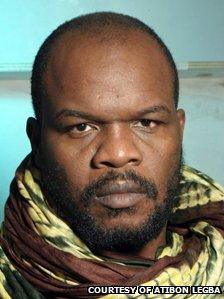Voodoo artists heal Haiti quake's aftershocks
- Published
voo
Two years after an earthquake devastated Haiti, Haitians in America have turned to traditional religious ritual for comfort. Leigh Paterson explains the power of voodoo (spelt 'vodou' in Creole).
They gather at a voodoo temple in a dark Brooklyn basement strewn with candles, plastic skulls and half-empty bottles of rum, the remains of a recent ceremony.
There, Haitian-American artists come to talk about their faith in voodoo and how it keeps them connected to their homeland.
"The religion is like a glue," says voodoo priestess Marie Saintil. "We attract each other. If a drum is beating, and someone hears it, the next thing you know, this place is packed."
That connection is especially important this month, on the two-year anniversary of the earthquake that devastated Haiti.
Since the quake, voodoo has played an important role in the healing process. Many of these Haitian immigrants have found comfort in the faith and community that voodoo cultivates, practitioners of the religion in the US say.
Fusion of beliefs
Haitian voodoo is an ancient practice that emerged among the first Africans brought to Haiti as slaves in the 16th Century.

Mr Legba says voodoo offers a link to nature and ancestors
Unable to practice their own diverse religions openly, the slaves fused them with the Catholic beliefs of the Spanish and French slavers.
From these complex beginnings voodoo has become an important part of Haitian culture, especially for those living far from home.
Marie Saintil came to Brooklyn more than 20 years ago.
"We advise, we help. Any time of the night and day, we get phone calls from our religious children," Ms Saintil says. "Sickness, family troubles, we are right in there."
The 2010 earthquake left homeless 1.5 million Haitians, some of whom came to the US.
About 48,000 Haitians arriving within a year after the quake were given temporary permission to stay, work and send money home, as were about 200,000 who had previously been in the US, according to the US Department of Homeland Security.
'Magic happens'
After the quake hit, Haitian communities across the US came together and used voodoo to make sense of the tragedy.
"This is where the magic happens, beauty happens, the healing happens, counselling happens," says Atibon Legba, a Brooklyn-based actor, gesturing to the darkened temple.
"With the knowledge of herbs and stars, we can heal."
Voodoo practitioner Neg Mawon, who was in Brooklyn when the quake struck, explained that by consulting certain voodoo spirits, he finally came to understand and accept what had occurred.
"When it happened, we were doing small groups of networking, trying to comfort each other," he says.
"We had so many voodoo ceremonies and musicians who had been playing fundraisers. We had a great support system in New York."
Brooklyn-based photographer Regine Romain visited Haiti two weeks after the quake and attributes many of the miraculous survival stories to the country's faith in voodoo.
"Our spiritual connection is what really helped us get past the tragedy," she says.
"I had to really start praying that people would be found. It is a land filled with magic, and a connection to that which was unseen.
"Whether you're voodooist, Christian, Baptist, Hindu, whatever your background is, there is an understanding that life is not permanent. And in the traditions of voodoo, there is peace that is made with death."